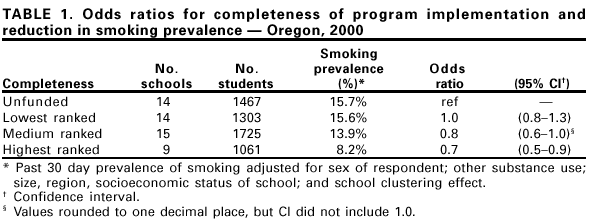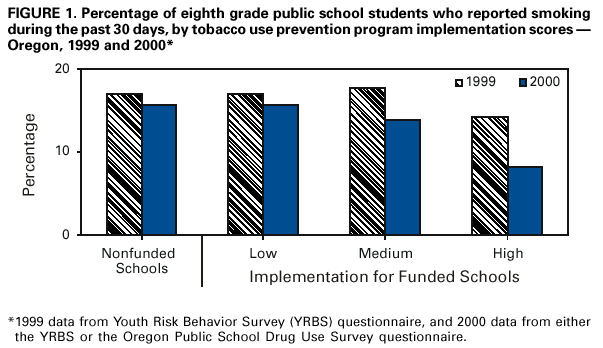 |
|
|
|
|
|
|
| ||||||||||
|
|
|
|
|
|
|
||||
| ||||||||||
|
|
|
|
|
Persons using assistive technology might not be able to fully access information in this file. For assistance, please send e-mail to: mmwrq@cdc.gov. Type 508 Accommodation and the title of the report in the subject line of e-mail. Effectiveness of School-Based Programs as a Component of a Statewide Tobacco Control Initiative --- Oregon, 1999--2000With funds available from revenue generated by a voter-initiated ballot measure to increase the state cigarette excise tax (1), the Oregon Health Division (OHD) created the Tobacco Prevention and Education Program (TPEP) in 1997. Coalitions in all Oregon counties, a countermarketing campaign, a statewide tobacco cessation quitters' helpline, and competitive grants to community groups, tribal associations, and school districts are supported by TPEP (2); 12% of TPEP's $8.5 million annual funding was used to implement CDC's Guidelines for School Health Programs to Prevent Tobacco Use and Addiction (3) in 23 school districts or consortia of districts. Data from annual school-based surveys conducted to monitor adolescent risk behavior indicated that from 1999 to 2000, 30-day smoking prevalence among eighth grade students declined more in funded schools than in a comparison group of nonfunded schools. The declines were significantly greater among schools with high and medium levels of implementation. These results suggest that comprehensive school-based programs can be an effective component of statewide antitobacco efforts. Data on smoking behavior among students were collected by OHD from either the Oregon Public School Drug Use Survey (OPSDUS) questionnaire or the Youth Risk Behavior Survey (YRBS) questionnaire. In 1999, 49 (53%) of 93 funded schools and 61 (25%) of 246 nonfunded schools used the YRBS questionnaire. In 2000, 58 funded schools and 47 nonfunded schools used either the OPSDUS or YRBS questionnaires. All analyses were based on data from 38 funded schools and 14 nonfunded schools that participated in both 1999 and 2000. Eighth graders were selected for analysis because TPEP's most intensive interventions targeted middle schools, which meant that eighth graders in 2000, who were seventh graders in 1999, had been exposed to the program for 2 years. Smoking prevalence for 1999 and 2000 was measured in both funded and nonfunded schools, and multivariate logistic regression was used to compare the 2000 difference in prevalence between the two groups of schools. Prevalence in 2000 in schools with high, medium, or low program implementation scores also was compared with 2000 prevalence in nonfunded schools. Among the 52 schools, 1942 (55%) of 3519 eighth graders surveyed attended funded schools in 1999. In 2000, 4089 (74%) of 5556 eighth graders surveyed attended funded schools. Funded schools were required to conduct an eighth grade student census; nonfunded schools participated on a voluntary basis. The number of participating students varied as a result of differences in sampling protocol between the two surveys. Without knowledge of the school survey results, each funded school district was categorized on cumulative implementation (progress before and during funding) of six areas identified in CDC guidelines (3): tobacco-free school policies, family involvement, community involvement, tobacco prevention curriculum instruction, teacher/staff training, and student tobacco use cessation support. Tobacco-free school policies were assessed by summing the number of elements completed out of 19 (3). Family involvement and student tobacco use cessation support were assessed by summing the total completed out of five criteria in each of two components (3). Community involvement was measured by whether the district sent a representative to community tobacco coalition meetings; teacher/staff training was assessed by whether the district had provided training during the survey period; and tobacco prevention curriculum instruction was assessed by the implementation of a CDC-identified curriculum. The quartile score for the first three areas (scored one to four) was added to the dichotomous measures of the latter three areas ("yes" was scored zero and "no" was scored one) for a final score that ranged from three (best score) to 15 (worst score). Based on natural cut-off points in the distribution of scores, the schools then were classified as low (nine--15), medium (six--eight), or high (three--five) on the six areas. Of the 38 participating funded schools, 14 were in low-ranked districts, 15 were ranked medium, and nine were ranked high on implementation criteria. Both the YRBS and OPSDUS self-report questionnaires were administered anonymously to all students in the participating eighth grade classrooms. The YRBS question used to determine smoking status was "During the past 30 days, on how many days did you smoke cigarettes?" The OPSDUS question was "How frequently have you smoked cigarettes during the past 30 days?" Students who indicated that they had smoked on >1 days were classified as smokers on each survey. In 1999, no statistical differences were observed in student or school characteristics, including eighth grade smoking prevalence, in funded versus nonfunded schools. The 30-day smoking prevalence decreased from 16.6% in 1999 to 13.0% in 2000 (p=0.002) in funded schools and from 17.0% in 1999 to 15.7% in 2000 (p=0.47) in nonfunded schools. Stratified by implementation level in 1999 and 2000, changes in prevalence among eighth grade students were larger in schools in districts with high (from 14.2% to 8.2%) or medium (from 17.8% to 13.9%) ratings; changes in smoking prevalence in schools in districts with low ratings (from 17.1% to 15.6%) were almost equal to those in nonfunded schools (from 17.0% to 15.7%) (Figure 1). Logistic regression was conducted to compare prevalence in funded and nonfunded schools and was adjusted for respondent sex, other substance use (e.g., alcohol, cocaine, marijuana, and inhalants), school size, school geographic location in state, and socioeconomic status of each school. Based on the regression model, students in the funded schools in 2000 were approximately 20% less likely to smoke (odds ratio=0.8; 95% confidence interval [CI]=0.7--1.0*) compared with students in nonfunded schools. School funding status in 1999 was not associated with student smoking prevalence. Based on similar multivariate logistic regression analyses using 2000 results, the odds of an eighth grade student reporting smoking during the past 30 days were lowest among schools in districts with high or medium cumulative implementation (Table 1). Reported by: K Rohde, MA, B Pizacani, MPH, M Stark, PhD, M Pietrukowicz, PhD, C Mosbaek, C Romoli, MPH, M Kohn, MD, J Moore, PhD, Oregon Health Div. Office on Smoking and Health and Div of Adolescent and School Health, National Center for Chronic Disease Prevention and Health Promotion, CDC. Editorial Note:The findings in this report suggest that a comprehensive school-based tobacco prevention program that includes tobacco-free school policies and community involvement as one component of a statewide tobacco program may contribute to reductions in current smoking among eighth graders (3). The significantly greater declines in smoking prevalence in the schools that rated high and medium on implementation criteria emphasize the importance of monitoring activity in funded school programs and the need for ongoing assistance to facilitate implementation of evidence-based recommendations (3). The findings in this report are subject to multiple limitations. Two different student surveys, each with slightly different questions, were used to measure prevalence. Question wording and context in the questionnaires may have affected responses (4). Funded districts self-selected to apply for the competitive grants to implement the tobacco prevention program and represented approximately one third of the public school students in Oregon. Among them, only 38 of 93 schools conducted school-based surveys in both 1999 and 2000. The nonfunded schools also represented a self-selected sample, and the 14 nonfunded schools with survey data from both 1999 and 2000 represented only 6% of all nonfunded Oregon schools. The funded and nonfunded schools may have differed in unmeasured characteristics (e.g., the effectiveness of a county coalition's antitobacco activities) that may have influenced 2000 smoking prevalence. In the multivariate analyses, sample clustering by school was represented in the analysis; however, variable sampling rates within each school could not be accounted for because information on these rates was unavailable. Student smoking prevalence was based on self-reports, and in schools with stronger programs, students might have underreported smoking because of stronger antismoking norms. No information was available on the student response rate for the schools in this study; however, the average student response rate for Oregon surveys using the YRBS questionnaire has been 78%. Changes in smoking prevalence from 1999 to 2000 were based on comparisons of cross-sectional samples of eighth graders rather than on a longitudinal cohort. Measurements of program implementation were based on coordinator self-reports and, although these reports assessed policies for a range of characteristics, they did not include measures of policy enforcement, and the self-reports could not be validated externally. Finally, the results of this study were based on a comparison of only 2 years of data, and further surveillance is necessary to confirm trends and the impact of this school-based program. The implementation of a tobacco prevention curriculum alone may be insufficient to prevent cigarette smoking among adolescents (5). CDC recommends a combination of tobacco-free school policies and an evidence-based curriculum linked to communitywide programs involving families, peers, and organizations. School-based activities are most effective when integrated with countermarketing campaigns and community-based activities (6). Several states, including Oregon, have reported declines in youth smoking rates after implementing multicomponent tobacco prevention and control efforts (2,7--9). Consistent with CDC's Best Practices for Comprehensive Tobacco Control Programs (10), the data in this report suggest that school-based programs can be an effective element of statewide tobacco prevention and education. References*
* Values rounded to one decimal place, but CI did not include 1.0. *All MMWR references are available on the Internet at <http://www.cdc.gov/mmwr>. Use the search function to find specific articles. Table 1  Return to top. Figure 1  Return to top. Disclaimer All MMWR HTML versions of articles are electronic conversions from ASCII text into HTML. This conversion may have resulted in character translation or format errors in the HTML version. Users should not rely on this HTML document, but are referred to the electronic PDF version and/or the original MMWR paper copy for the official text, figures, and tables. An original paper copy of this issue can be obtained from the Superintendent of Documents, U.S. Government Printing Office (GPO), Washington, DC 20402-9371; telephone: (202) 512-1800. Contact GPO for current prices. **Questions or messages regarding errors in formatting should be addressed to mmwrq@cdc.gov.Page converted: 8/10/2001 |
|||||||||
This page last reviewed 8/10/2001
|